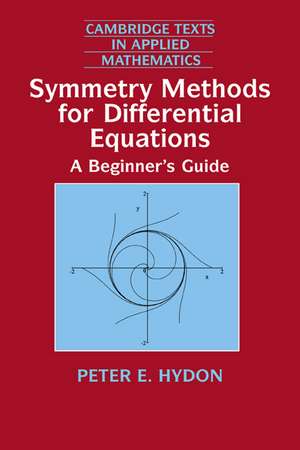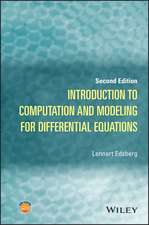Symmetry Methods for Differential Equations: A Beginner's Guide: Cambridge Texts in Applied Mathematics, cartea 22
Autor Peter E. Hydonen Limba Engleză Paperback – 27 ian 2000
| Toate formatele și edițiile | Preț | Express |
|---|---|---|
| Paperback (1) | 413.77 lei 6-8 săpt. | |
| Cambridge University Press – 27 ian 2000 | 413.77 lei 6-8 săpt. | |
| Hardback (1) | 896.69 lei 6-8 săpt. | |
| Cambridge University Press – 12 feb 2000 | 896.69 lei 6-8 săpt. |
Din seria Cambridge Texts in Applied Mathematics
- 8%
 Preț: 499.26 lei
Preț: 499.26 lei - 8%
 Preț: 440.29 lei
Preț: 440.29 lei - 14%
 Preț: 1064.13 lei
Preț: 1064.13 lei -
 Preț: 343.21 lei
Preț: 343.21 lei -
 Preț: 322.29 lei
Preț: 322.29 lei -
 Preț: 488.47 lei
Preț: 488.47 lei -
 Preț: 388.23 lei
Preț: 388.23 lei -
 Preț: 344.44 lei
Preț: 344.44 lei -
 Preț: 344.44 lei
Preț: 344.44 lei -
 Preț: 486.56 lei
Preț: 486.56 lei -
 Preț: 342.85 lei
Preț: 342.85 lei - 8%
 Preț: 498.75 lei
Preț: 498.75 lei - 11%
 Preț: 434.35 lei
Preț: 434.35 lei - 11%
 Preț: 461.17 lei
Preț: 461.17 lei - 11%
 Preț: 543.61 lei
Preț: 543.61 lei - 11%
 Preț: 568.02 lei
Preț: 568.02 lei -
 Preț: 420.24 lei
Preț: 420.24 lei -
 Preț: 288.82 lei
Preț: 288.82 lei - 11%
 Preț: 618.20 lei
Preț: 618.20 lei - 11%
 Preț: 572.63 lei
Preț: 572.63 lei -
 Preț: 453.36 lei
Preț: 453.36 lei - 11%
 Preț: 502.39 lei
Preț: 502.39 lei - 11%
 Preț: 421.48 lei
Preț: 421.48 lei -
 Preț: 386.88 lei
Preț: 386.88 lei - 11%
 Preț: 444.11 lei
Preț: 444.11 lei - 11%
 Preț: 522.04 lei
Preț: 522.04 lei -
 Preț: 379.96 lei
Preț: 379.96 lei - 11%
 Preț: 592.23 lei
Preț: 592.23 lei - 11%
 Preț: 491.72 lei
Preț: 491.72 lei - 11%
 Preț: 619.90 lei
Preț: 619.90 lei - 11%
 Preț: 451.14 lei
Preț: 451.14 lei - 11%
 Preț: 454.21 lei
Preț: 454.21 lei -
 Preț: 300.32 lei
Preț: 300.32 lei
Preț: 413.77 lei
Preț vechi: 464.92 lei
-11% Nou
Puncte Express: 621
Preț estimativ în valută:
79.18€ • 84.67$ • 66.01£
79.18€ • 84.67$ • 66.01£
Carte tipărită la comandă
Livrare economică 18 aprilie-02 mai
Preluare comenzi: 021 569.72.76
Specificații
ISBN-13: 9780521497862
ISBN-10: 0521497868
Pagini: 228
Ilustrații: 8 b/w illus.
Dimensiuni: 153 x 230 x 26 mm
Greutate: 0.34 kg
Ediția:0002
Editura: Cambridge University Press
Colecția Cambridge University Press
Seria Cambridge Texts in Applied Mathematics
Locul publicării:Cambridge, United Kingdom
ISBN-10: 0521497868
Pagini: 228
Ilustrații: 8 b/w illus.
Dimensiuni: 153 x 230 x 26 mm
Greutate: 0.34 kg
Ediția:0002
Editura: Cambridge University Press
Colecția Cambridge University Press
Seria Cambridge Texts in Applied Mathematics
Locul publicării:Cambridge, United Kingdom
Cuprins
1. Introduction to symmetries; 1.1. Symmetries of planar objects; 1.2. Symmetries of the simplest ODE; 1.3. The symmetry condition for first-order ODEs; 1.4. Lie symmetries solve first-order ODEs; 2. Lie symmetries of first order ODEs; 2.1. The action of Lie symmetries on the plane; 2.2. Canonical coordinates; 2.3. How to solve ODEs with Lie symmetries; 2.4. The linearized symmetry condition; 2.5. Symmetries and standard methods; 2.6. The infinitesimal generator; 3. How to find Lie point symmetries of ODEs; 3.1 The symmetry condition. 3.2. The determining equations for Lie point symmetries; 3.3. Linear ODEs; 3.4. Justification of the symmetry condition; 4. How to use a one-parameter Lie group; 4.1. Reduction of order using canonical coordinates; 4.2. Variational symmetries; 4.3. Invariant solutions; 5. Lie symmetries with several parameters; 5.1. Differential invariants and reduction of order; 5.2. The Lie algebra of point symmetry generators; 5.3. Stepwise integration of ODEs; 6. Solution of ODEs with multi-parameter Lie groups; 6.1 The basic method: exploiting solvability; 6.2. New symmetries obtained during reduction; 6.3. Integration of third-order ODEs with sl(2); 7. Techniques based on first integrals; 7.1. First integrals derived from symmetries; 7.2. Contact symmetries and dynamical symmetries; 7.3. Integrating factors; 7.4. Systems of ODEs; 8. How to obtain Lie point symmetries of PDEs; 8.1. Scalar PDEs with two dependent variables; 8.2. The linearized symmetry condition for general PDEs; 8.3. Finding symmetries by computer algebra; 9. Methods for obtaining exact solutions of PDEs; 9.1. Group-invariant solutions; 9.2. New solutions from known ones; 9.3. Nonclassical symmetries; 10. Classification of invariant solutions; 10.1. Equivalence of invariant solutions; 10.2. How to classify symmetry generators; 10.3. Optimal systems of invariant solutions; 11. Discrete symmetries; 11.1. Some uses of discrete symmetries; 11.2. How to obtain discrete symmetries from Lie symmetries; 11.3. Classification of discrete symmetries; 11.4. Examples.
Recenzii
'Hydon's book stands out as perhaps the best introductory level text currently available … Hydon's book is extremely well-written, and a welcome addition to the literature on Lie's methods. The author has clearly devoted a lot of effort to pedagogical details, and the exposition is designed to effortlessly bring the beginning student up to speed in basic applications of the method.' Peter Olver, ZAMM
'I really enjoyed reading this book and I am planning on using some parts for one of my next courses.' Monatshefte für Mathematik
'… a nice introduction to symmetry methods for ordinary and partial differential equations written with passion by a specialist … after a few pages it becomes clear that the book is written in a lucid and precise manner.' Zentralblatt MATH
'This new book by Peter Hydon … is eminently suitable for advanced undergraduates and beginning postgraduate students … Overall I thoroughly recommend this book and believe that it will be a useful textbook for introducing students to symmetry methods for differential equations.' Journal of Nonlinear Mathematical Physics
'Throughout the text numerous examples are worked out in detail and the exercises have been well chosen. this is the most readable text on this material I have seen and I would recommend the book for self-study (as an introduction).' MathSciNet
'It is very suitable for, and is specifically aimed at, postgraduate courses in the field. it is the more enjoyable for being written with infectious enthusiasm and there is a good selection of examples.' Mathematical Gazette
'I really enjoyed reading this book and I am planning on using some parts for one of my next courses.' Monatshefte für Mathematik
'… a nice introduction to symmetry methods for ordinary and partial differential equations written with passion by a specialist … after a few pages it becomes clear that the book is written in a lucid and precise manner.' Zentralblatt MATH
'This new book by Peter Hydon … is eminently suitable for advanced undergraduates and beginning postgraduate students … Overall I thoroughly recommend this book and believe that it will be a useful textbook for introducing students to symmetry methods for differential equations.' Journal of Nonlinear Mathematical Physics
'Throughout the text numerous examples are worked out in detail and the exercises have been well chosen. this is the most readable text on this material I have seen and I would recommend the book for self-study (as an introduction).' MathSciNet
'It is very suitable for, and is specifically aimed at, postgraduate courses in the field. it is the more enjoyable for being written with infectious enthusiasm and there is a good selection of examples.' Mathematical Gazette
Descriere
An introduction to symmetry methods, informally written and aimed at applied mathematicians, physicists, and engineers.
















